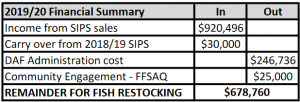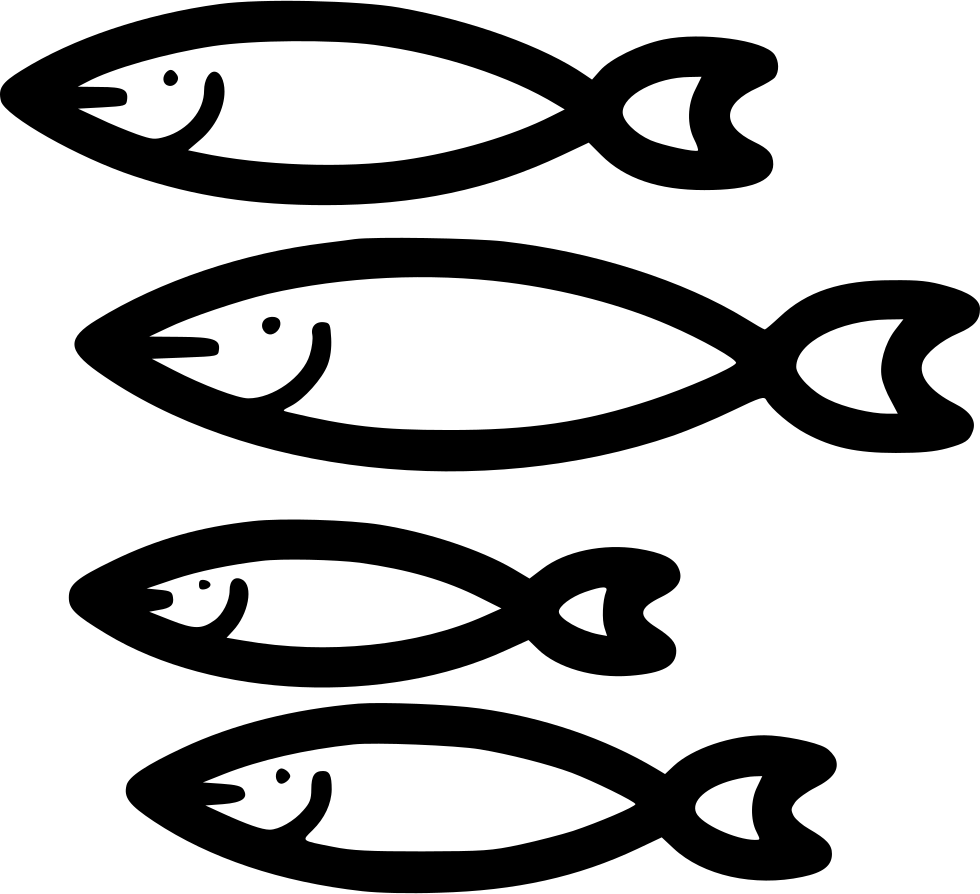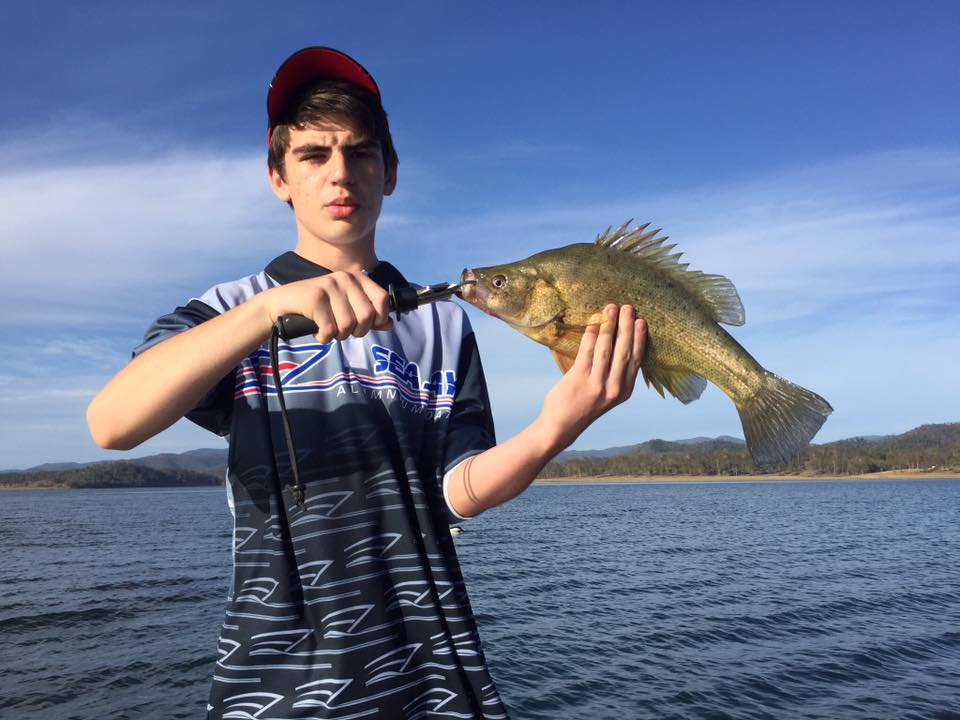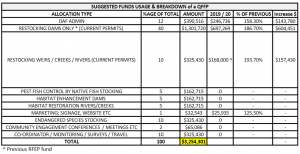Queensland Freshwater Fishing Permit – QFFP. (Proposal)
A new proposal to managing recreational freshwater fisheries in Queensland
Intention
To discover what a Queensland wide freshwater fishing permit would look like and what the potential benefits would be, if the current SIPS permit is expanded to cover all non-tidal waters (fresh waters) of Queensland.
Introduction
Fishing in Queensland is the single most popular recreational activity, of that, freshwater fishing represents around 22% of the total effort (QFISH Recreational Fishing Survey 2013/14). As most desirable recreational freshwater fish species breeding cycle is broken due to man-made barriers, on-going restocking is required. No restocking = no fishery. The increase in man-made barriers (dams, weirs, barrages), the removal of riparian vegetation and increased water harvesting has put greater pressure on native fish stocks making the need for restocking to be more important than ever before.
As such, the Qld Fisheries Department at the request of fish restocking bodies developed the SIPS permit scheme in 2000.
Prior to the establishment of the SIPS, Qld Fisheries provided around $168,000/annum in the form of grants to fish restocking groups across Qld under the Recreational Fisheries Enhancement Program (RFEP).
Due to Qld Govt budget cuts the RFEP was abolished. This meant that all non-tidal waters in Qld that were NOT able to be included in the SIPS were cut off from all financial assistance. This in many cased has meant that these effected fish stocking groups & their programs have vastly reduced the numbers of fish stocked.
To off-set this to some degree, the SIP was expanded from true dams/lakes to include smaller weirs. This assisted some fish restocking groups while at the same time diluted the funding going to the original SIPS impoundments (dams / lakes).
Currently there are 63 waterways that receive SIPS funds (40 Dams / 23 weirs), however there are in excess of 100 other stocked waterways that receive no funding support from SIPS or Qld Govt.
Many restocking groups that receive SIPS funding believe that the SIPS program 20 years after it started is not fulfilling the original intent with concerns around reduced funding for restocking.
QFFP Concept
- To expand the current Stocked Impoundment Permit Scheme (SIPS) to cover all non-tidal waters in Qld.
- To ensure that wild native freshwater fish populations experience no further decline in numbers.
- To see continued growth of recreational freshwater fishing opportunities across Qld.
- To play a role in controlling introduced noxious fish species by maintaining healthy native fish populations & habitat.
- To ensure that recreational freshwater fishing will still be viable for future generations.
- Have consistency across all non-tidal waters as to where does & does not require a permit. This should reduce confusion with anglers, improve ability of B&FP to enforce the permit & therefore increase compliance rates. Eg if someone has a golden perch in their ice-box it has obviously come from fresh water.
General Principles of a QFFP
- Apply to all non-tidal public or crown waters of Qld,
- Along lines of current SIPS, a QFFP to be required for all persons 18 years and over,
- Current bag limits, size limits, closed to waters & closed seasons to be maintained,
- The use of all apparatus including line fishing, traps, pots, dillies and hand scoops in all non-tidal waters of Qld would require a QFFP, excluding privately owned dams on private property. Any fish caught on private waters are to be consumed on that property, or a QFFP must be held if taken off property. Bag & size limits apply,
- monies to be held by & disseminated by a trust,
- be used to raise funds to maintain, manage & measure freshwater fisheries in Qld. This should include but not limited to:
- Recreational freshwater fisheries enhancement
- Threatened species
- Re-establishment of freshwater fish species in decline
- Habitat rehabilitation – freshwater
- Habitat enhancement – lakes / dams
- Noxious fish control via fish restocking
- Development of new fisheries i.e. new species for stocking in lakes eg Jungle Perch, or seed funding for new impoundments.
2019/20 Stocked Impoundment Permit Scheme (SIPS)

In 2019/20 the Qld SIPS permit system charges were as follows:
- Yearly permit $50
- Weekly permit $10
- Yearly discount permit (concession card holders) $36
Total permits issued 37,545
Average price per permit $24.52

QFISH Recreational Fishing Surveys
The 2013/14 QFISH Recreational Fishing Survey 2013/14 showed a total of 642,000 recreational anglers in Qld that year. Of these 22% of the effort was in fresh water.

Due to a change in the survey method / questions In 2019/20 the QFISH Recreational Fishing Survey was unable to accurately calculate the number of anglers that fished freshwater. If we take the 22% of freshwater anglers in 2013/14 survey and lay that over the total of the 2019/20 anglers we end up in excess of 207,000 freshwater anglers in 2019/20.
SIPS anglers Vs all of state
Recreational fishing participation in Qld has increased from 642,000 to in 2013/14 to 943,000 in 2019/20; an increase of 301,000 or 46.9% over 6 years.

How does the above information tell us what a QFFP would look like?
Total Anglers 2019/20 943,000 QFISH Recreational Fishing Survey 2019/20
Freshwater anglers 22% QFISH Recreational Fishing Survey 2013/14
______________________________
Under 18 Years of age. The QFISH surveys do not include data for people under 5 years of age. To get an approximate percentage of the amount required to reduce the 5-18 year old people for excluding (do not require a fishing permit) we can refer to the Australian Bureau of Statistics which states that the percentage of population 0-14 years of age is 19.28% in 2019. A 20% allowance for under 18 year old people has been used in these calculations.
Non-Compliance. Boating & Fisheries Patrol (B&FP) field staff have stated that they estimate the non-compliance at current SIPS locations is at around 10%. Many recreational anglers & stocking groups believe that non-compliance may be significantly higher than the 10% stated by B&FP. For this exercise a 20% allowance has been used as a more realistic estimate.
Average Permit Cost. If the same fee structure is carried over from the current SIPS, it is reasonable to estimate that the break-down of permit type & average cost of each permit will also not change.
Other Apparatus. Increase in permit sales due to other apparatus; eg crayfish pots, traps, dillies, hand nets/scoops etc. This is an unknown. In some areas people using shrimp / crayfish traps exceeds the number of people line fishing. There is no way of estimating this across the state so NO allowance has been made in these estimates as to the possible increase in permits sales the inclusion of other apparatus would generate. Could this see an increase of 5-10% of the estimate below?
It is worth noting that the inclusion of all apparatus in a fishing permit will make enforcement easier for B&FP staff.

______________________________
What can be done with the income from a Qld Freshwater Fishing Permit?
- Administration costs to DAF maintained / increased.
- Increase in the restocking of dams / lakes for recreational fishing enhancement. This would see an increase in the funds available for stocking the popular lakes & dams driving an increase in fishing at locations that have the infrastructure & facilities to accommodate higher visitation rates. At the same time this should draw pressure off wild fisheries, both freshwater & salt water.
- Restocking of creeks, rivers weirs for recreational fishing enhancement (locations currently stocked) – this would replace the old RFEP funding seeing fishing opportunities increase in regional areas.
- Pest Fish Control. Allocation of funding towards the stocking of native predator fish in waters not currently stocked – to control introduced noxious fish species such as carp & tilapia. Noting that this would not totally eradicate these pest fish, but would assist in keeping their numbers low. Used in conjunction with other strategies stocking of native fish would increase the efficacy of other control measures. Allow other bodies such as land care groups, local Govt authorities etc to apply for a permit to stock & apply for part funding of their program on a dollar for dollar basis. This will double the reach & impact of the funding.
Currently $0 spent on this by Fisheries Qld.
At the same time the increased presence of native predator fish offer improved recreational fishing opportunities. A win / win scenario. - Habitat Enhancement in Impoundments. There are structure enhancement programs currently being trialed at several dams/lakes. Cressbrook, Kinchant, Leslie, Mt Morgan & North Pine Dams have had structure added to attract fish to more desirable locations within the lake. It is envisioned that these type of programs will expand in coming years. Providing funding for these will give a better return on investment for fish restocking, improve recreational fishing experiences and provide better habitat for fish to live and in some cases breed.
- Habitat Restoration – creeks & rivers. Several generations of land clearing, mining, agriculture etc have added pressure to wild fish populations. Examples:
- Mary River cod (Endangered)
- Brisbane River Cod (Extinct)
- Lungfish (vulnerable)
- Silver perch in the Murray Darling
- Fitzroy strain golden perch
The re-establishment of riparian vegetation could see the need to restock native fish reduced or removed in the future.
- Endangered / threatened Species Restocking. Currently there is no budget from Queensland Govt for the restocking of endangered / threatened fish. At present, virtually all restocking permits and programs are aimed at fishing enhancement. An injection of funds could see a concerted system wide restocking effort into species like Silver Perch in the Murray Darling, Fitzroy strain golden perch or even assistance to protecting the River Blackfish at Killarney or the Bloomfield River Cod in Nth Qld. Currently $0 budget by Fisheries Qld.
- Mary River Cod Recovery Plan.
- Jungle Perch Recovery. Once found in all coastal waterways from Cape York to norther NSW, Jungle Perch are locally extinct in almost all waters south of Mackay.The Breeding technology is now known. A recovery plan could be funded under this proposal. Currently $0 budget by Fisheries Qld.
- Marketing of freshwater fishing in Qld including signage at popular locations.
- Community Engagement. Conferences / Meetings / Seminars / public Info sessions.
- Co-ordinator / Researcher. Employ an independent qualified person (external to DAF) that could:
- distribute grants
- assess applications
- conducting electrofishing surveys to assist stocking groups & research purposes,
- react to / assess fish kills ,
- Identify threats to fish populations eg barriers, plunge pools,
- Liaise with water authorities, DAF, DES etc providing feed-back on findings,
- conduct research / monitoring / assessment of programs listed previously; habitat, noxious fish control, status of threatened / endangered species,
- provide technical assistance to fish restocking groups, programs where needed,
- maintain / collate / analyse & create reports on boat ramp surveys, fishing app data & research / monitoring work conducted,
- coordinate annual / bi-annual workshop / conference,
- make representations on behalf of stocking groups to various levels of Govt.
Employed by the freshwater, working for freshwater.
No down time when Govt goes into election mode.
The role would require the use of electro-fishing boat, vehicle & travel costs.
___________________________
Requirements for a Successful QFFP Program
For a Qld Freshwater Fishing Permit to work the following are critical:
- Funds collected and disseminated by a Recreational Fishing Trust similar to NSW model.
- The use of all apparatus used in all non-tidal waters needs to require a permit. People using nets, traps, pots, dillies etc still take up camp sites on the land, use facilities / amenities, use boat ramps, take up space at car parks and of course hinder line fishing with their traps, ropes, floats etc being in the way of fishing or becoming entangled in fishing lines. The removal of shrimps / crayfish reduces the available food for fish & as such impacts the fishery overall. Therefore the use of all apparatus should be included.
- If a Qld Freshwater Fishing Permit is to be implemented, anglers with a permit MUST be deemed to acting on behalf of the state. This is to extinguish Qld Land Act 1994 – Division 3, 13a (4) (4)“A person (the owner) who may take water under the Water Act 2000, section 96—
(a) may exercise a right of access for the owner, the owner’s family, executive officers, employees, agents and stock over the part (the adjacent area) of the watercourse or lake that is the property of the State and that adjoins the owner’s land; and
(b) may exercise a right of grazing for the person’s stock over the adjacent area; and
(c) may bring action against a person who trespasses on the adjacent area as if the owner were the registered owner of the adjacent area.”
If paying for a freshwater permit, anglers must have free access to crown land along non-tidal water courses (some lakes excluded for safety / security reasons)
The above would bring Qld in line with other states. Currently there are two differing sets of laws covering NSW / Qld border rivers.
- Unused funds may be held over by the trust if no suitable applications are received that year.
Benefits from Expanding the SIPS to a QFFP
- Increase in funding for fish restocking for currently stocked waterways = better recreational fishing,
- New fish restocking opportunities = wider reach of improved recreational fishing other than current SIPS lakes & weirs,
- Increased spend with commercial fish hatchery operators = more employment in aquaculture sector,
- Restoration of endangered / threatened fish species,
- Improved habitat along waterways = more homes for fish, birds, insects etc,
- Control of introduced noxious fish e.g. carp, tilapia, pearl cichlids.
- More people fishing in freshwater locations takes pressure off all other fisheries, estuary, offshore etc and associated infrastructure
- Increased freshwater fishing opportunities will provide greater lifestyle for rural / regional residents as well as creating draw cards for tourism.
- Simplified enforcement by B&FP staff. An all fresh water permit would see the removal of any confusion as to which location requires a permit & which does not. If the water is non-tidal a permit would be required,
- Improved water quality through a more balanced eco-system, & a reduction in water treatment costs.
Conclusion
A study of the economic value of recreational fishing at SIPS dams found that – the total economic value of recreational fishing at the SIPS dams is predicted to be approximately $95.3 Million per annum. Gregg, D & Rolfe, J. 2013 An economic assessment of the value of recreational angling at Queensland dams involved in the Stocked Impoundment Permit Scheme
With a potential 300% + increase in fish restocking as a result of a QFFP & the flow on benefits to recreational fishing it stands to reason that there will be a direct and corresponding increase in the economic value of freshwater fishing in Queensland.
Download this document (pdf format)
__________________________________________
Many thanks to Ausfish.com.au for supporting this initiative.
Ausfish is Australia’s Premier Fishing Forum. Go to Ausfish.com.au
Thank you to Sweetwater Fishing Australia for supporting this page.
As the name suggests, Sweetwater Fishing is a site dedicated to the great freshwater fish of Australia. Go to Sweetwater Fishing Australia
Data collected from these fishing surveys is for the purpose of evaluating, measuring & monitoring fisheries; primarily waterways stocked with native fish.
The surveys also lend themselves to individual research programs, or fishing competitions.
Data collected is for the individual restocking groups / researchers use. Data collected is not for the purpose of on-selling to 3rd party.
Data may be shared with Fisheries department upon request.


